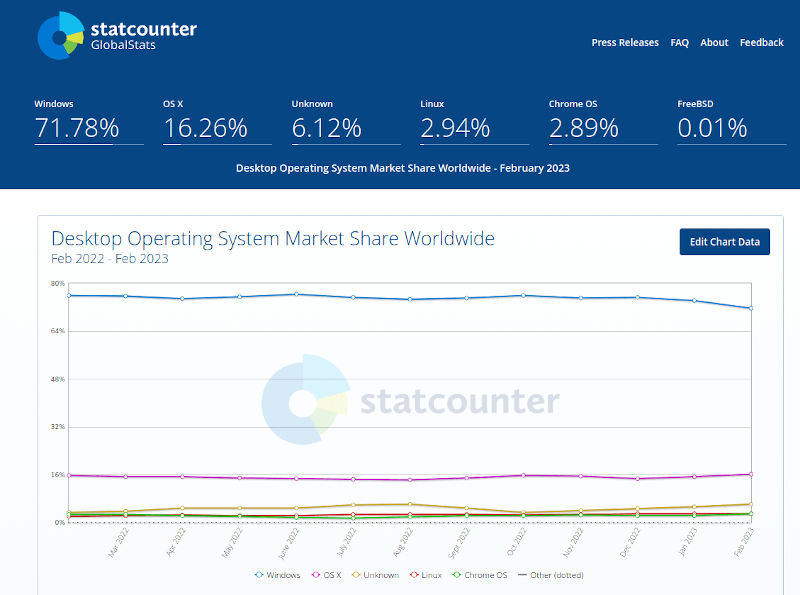Linux is a free and open-source operating system or kernel that continues to gain popularity in the digital space. Developed by Linus Torvalds in 1991, Linux is widely used in servers, supercomputers, and mobile devices.
It is popular for its stability, security, and flexibility, making it a favorite among developers, system administrators, and end-users.
Unlike proprietary operating systems such as Microsoft Windows and macOS, Linux is built on a collaborative model where developers worldwide contribute to its development. This feature explains why you will find several Linux distributions, each tailored to specific user needs and preferences.
This article will introduce you to Linux, its history, features, and applications. Whether you’re a developer, a system administrator, or a curious end-user, this article will give you a solid understanding of Linux, its basics, and its capabilities.
History of Linux Operating System
In 1991, a Finnish computer science student named Linus Torvalds began working on a new operating system as a hobby. He was inspired by the Unix operating system, widely used in universities and research institutions then.

Torvalds began developing his new operating system on a personal computer using the Intel 386 processor, and he named it “Linux” after himself and the Unix operating system. He released the first version of Linux to the public in September of that year, and it quickly gained popularity among computer enthusiasts.
As more people began using Linux, a community of developers formed around the project to contribute code, fix bugs and add new operating system features. Linux also benefited from the broader open-source movement, which encouraged collaboration and sharing among developers.
In the early years, Linux was mainly used by hobbyists and enthusiasts, but it also began to gain traction in the business world. By the late 1990s, companies like IBM, Oracle, and Red Hat had begun to invest in Linux, recognizing its potential as a stable, scalable, and cost-effective operating system for servers and other enterprise applications.
Today, Linux is used in various applications, from mobile devices and personal computers to servers and supercomputers. It powers most of the world’s web servers and is the operating system of choice for many cloud computing platforms.

Despite its success, Linux remains true to its open-source roots. It is developed by a community of developers worldwide who continue to collaborate and innovate to keep the operating system at the forefront of technology. Of course, it stands out as one of the open-source projects to which you can contribute.
Benefits of Using the Linux Operating System
Linux continues to grow in popularity exclusively for the benefits that it provides.
Some of the advantages of this OS include the following:
- Free and Open-Source – Linux OS is free to use, modify, and distribute. Its source code is open and available to anyone, so developers can modify and customize it to suit their needs. This feature explains why a vibrant ecosystem of Linux distributions and software is constantly evolving and improving. The OS exists under the GNU General Public License.
- Security – Linux is inherently more secure than many other operating systems, which is built on a strong security model that includes file permissions, user management, and encryption features. Since it has an open-source code, developers always quickly discover and patch any issues. Besides, several security-focused distros exist, such as Qubes OS, Kali Linux, Tails, and many more.
- Stability – Linux is known for its stability and reliability. It can run for long periods without being restarted or experiencing crashes. This makes it ideal for use in servers where uptime is critical.
- Flexibility – Linux is highly customizable and flexible. It can be used on several hardware platforms and configured to suit various needs, from desktop computing to high-performance computing and everything in between.
- Compatibility – Linux is compatible with various software applications and hardware devices. Users can access a vast library of software and hardware options without worrying about compatibility issues.
- Large Community – Linux has a vibrant and supportive community of developers and users. This community is constantly working to improve the operating system and support users new to Linux.
Linux is a powerful and versatile operating system that offers numerous advantages over other operating systems. Its open-source nature, security, stability, flexibility, compatibility, and supportive community make it an attractive option for developers, system administrators, and end-users.
Understanding Linux Distributions
Linux distributions, or “distros” for short, are different flavors of the Linux operating system tailored to specific user needs and preferences. While all Linux distros share a common core, they can differ significantly in terms of software packages, security features, user interface, and system architecture.
There are about 1000 Linux distros available, each with its strengths and weaknesses. You will find an array of beginner-friendly Linux distros and other advanced distros which are ideal for expert users for more technical applications.
Some popular open-source Linux distros include Ubuntu, Debian, Fedora, Linux Mint, CentOS, and Arch Linux. These are just a few examples of the many Linux distributions available.
When choosing a Linux distro, you must consider your user needs, hardware compatibility, software availability, and support options. By selecting the right Linux distribution, users can customize their computing experience and take advantage of the benefits of Linux.
Linux Operating System Design and Architecture
The design of the Linux operating system leverages the Unix operating system, which is known for its modularity, scalability, and flexibility. Linux is designed to be modular, implying that its components can be replaced or customized to meet specific user needs.
Notably, all distros have a universal architecture but feature some specific customization aspects. We can breakdown the architectural design of the OS into several key components, as shown:
- Kernel – The Linux kernel is the core of the operating system, which provides low-level services such as process management, memory management, and device drivers.
- Shell – The shell is a command-line interface that allows users to interact with the operating system. The shell is responsible for executing commands and managing input and output.
- System Libraries – System libraries are collections of pre-written code that provide common functions to applications. These libraries are used by higher-level applications to interact with the kernel and other system services.
- User-Space Applications – User-space applications are the programs that users interact with directly. These applications provide a graphical user interface (GUI), web browsing, email, and other user-facing functionality.
- System Daemons – System daemons are background processes that run continuously to provide system services such as printing, network services, and system monitoring.
- File System – Linux uses a hierarchical file system organized into directories and files. The kernel manages the file system, which provides services for accessing and modifying files.
- Device Drivers – Device drivers communicate with hardware devices such as printers, network cards, and disk drives.
Linux also supports virtualization, which allows multiple operating systems to run on the same hardware. This is made possible by the Linux kernel’s support for virtualization technologies such as KVM and Xen.
The layered architecture separates system services and applications into different layers, making maintaining and upgrading the system easier. The support for virtualization also makes Linux an attractive choice for cloud computing and server virtualization.
Uses of The Linux Operating System
Linux is a versatile and powerful operating system used in several applications and industries. Its flexibility, security, and open-source nature make it an attractive choice for many users and organizations.
Some of the most common uses of Linux include:
- Servers – Linux is widely used as a server operating system due to its stability, security, and scalability. Many web, email, file, and database servers run on Linux.
- Cloud Computing – Linux is the preferred operating system for cloud computing, with many cloud providers offering Linux-based virtual machines and containers.
- Embedded Systems – Linux is used in many embedded systems, such as smart TVs, routers, and IoT devices. Its open-source nature and modularity make it a popular choice for embedded systems.
- Supercomputers – Linux is widely used in high-performance computing and scientific research, with many of the world’s most powerful supercomputers running on Linux.
- Desktops and Laptops – While Linux is not as widely used on desktops and laptops as Windows or macOS, it is a popular choice for developers, computer enthusiasts, and users who value privacy and security.
- Education – Linux is widely used in education, both in K-12 schools and universities. Its open-source nature and low cost make it an attractive choice for educational institutions.
- Mobile Devices – Linux-based operating systems such as Android and Sailfish OS are used in many smartphones and tablets.
Conclusion
The benefits of Linux are numerous, including improved security, stability, and performance and the ability to customize and modify the operating system to meet specific user needs.
Linux’s layered architecture and modular design make it easier to maintain and upgrade. Besides, its support for virtualization technologies like KVM and Xen makes it an attractive choice for cloud computing and server virtualization.
Whether you are a developer, a system administrator, or a casual user, Linux offers a powerful and reliable platform for computing that is well worth exploring.

Linus Torvalds IS NOT the person that changed the original name to Linux…
The Linux operating system has a previous name.
Do your job: find out what was the first original name and who (hint: it’s not Linus) changed the name and when.
I won’t bother reading the rest of the article as it started with something blatantly false.